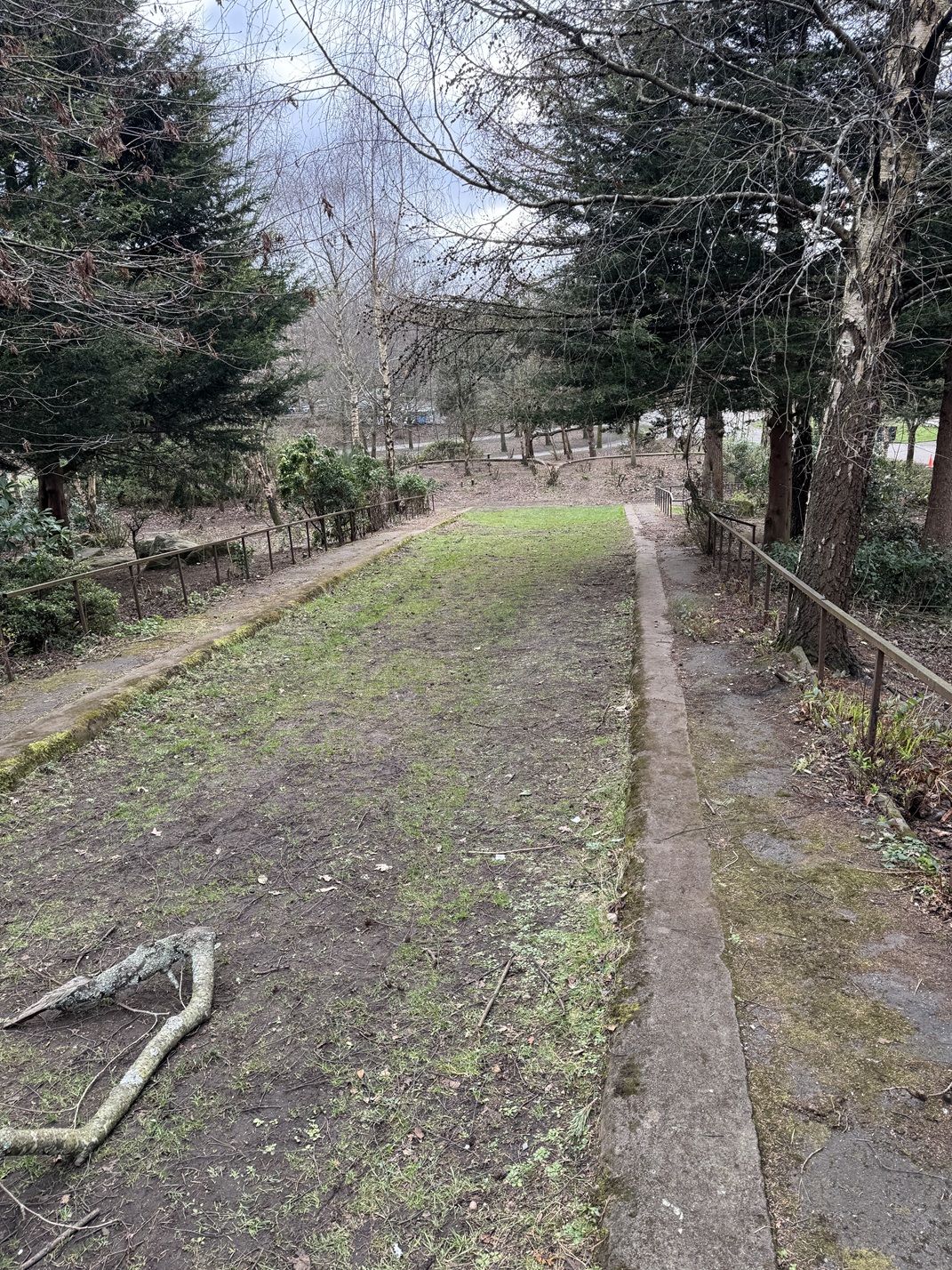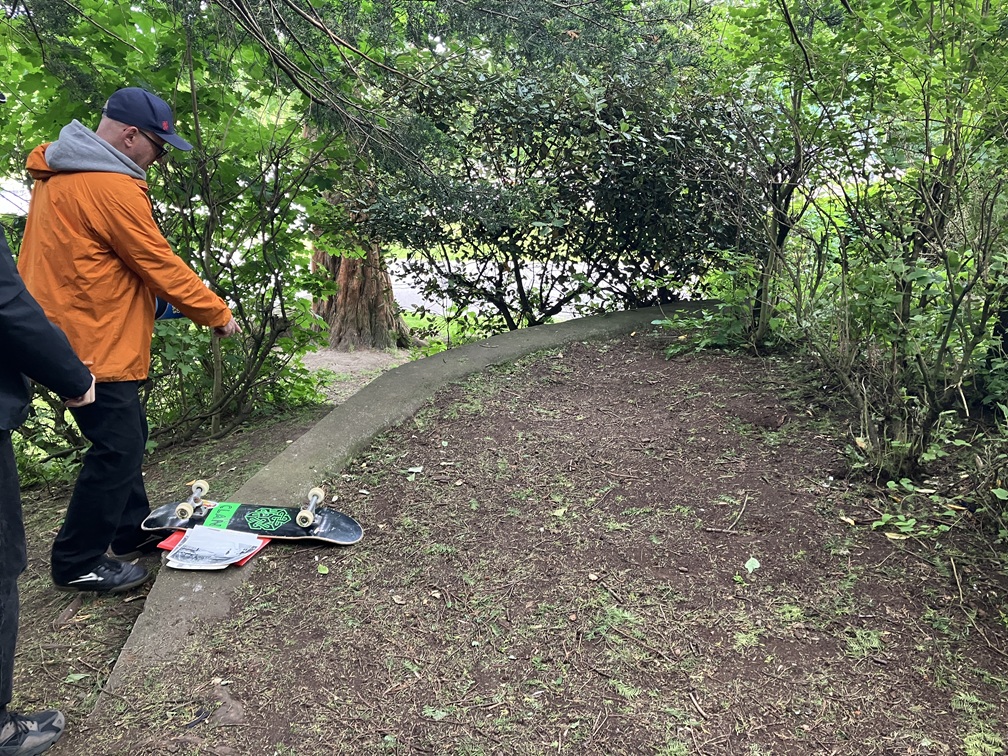Kelvin Wheelies and Glasgow skatepark heritage Project
This project is a contemporary archaeology exploration of an almost forgotten part of Glasgow’s recent sporting heritage – the Kelvin Wheelies skatepark. Situated in Kelvingrove Park in the city’s Westend, this skatepark was operated by Glasgow City Council. It opened in May 1978, and was initially hugely popular. There was also an adjacent freestyle zone, once a roller disco, and now a modern skatepark. The ticketed first Kelvingrove skatepark was state-of-the-art, with bowls, slalom run, clover bowl and half-pipe, as well as associated ticket booth, café and toilets. Growing concerns about maintenance costs and safety led to closure then burial by 1983.
Elements of the skatepark remains visible in Kelvingrove Park today, but there is no information available to explain the significance of this site to park visitors or users of the adjacent modern skatepark. A place that was a central part of modern Glasgow’s sporting heritage and the lives of hundreds of teenagers is in danger of being forgotten and lost. This is a vital part of Scotland’s sporting heritage and the Kelvingrove skatepark was the first major concrete venue for skateboarding built in Scotland.
This skatepark was created as part of the so-called ‘second wave’ of concrete skateparks that emerged internationally in the 1970s. Some of these skateparks have gone on to become Listed and protected structures, the closest to Glasgow being the Livi skatepark in Livingston. This was Category B Listed by HES in 2024. But more commonly, these skateparks were closed and either removed or buried. The Skatepark Heritage Research Group has further information on other skateparks globally and their heritage significance, and works to support research into ‘buried’ concrete skateparks.
This is a project that is a collaboration with the skateboarding community in Glasgow, and in particular Jamie Blair, of Clan Skates, Partick, who has written a history of the skatepark. In that history, Jamie concluded “It’s still possible to see some evidence of the old park peeping out from the undergrowth, and over the years there have been a few calls to do a dig and get back to some old school action”.
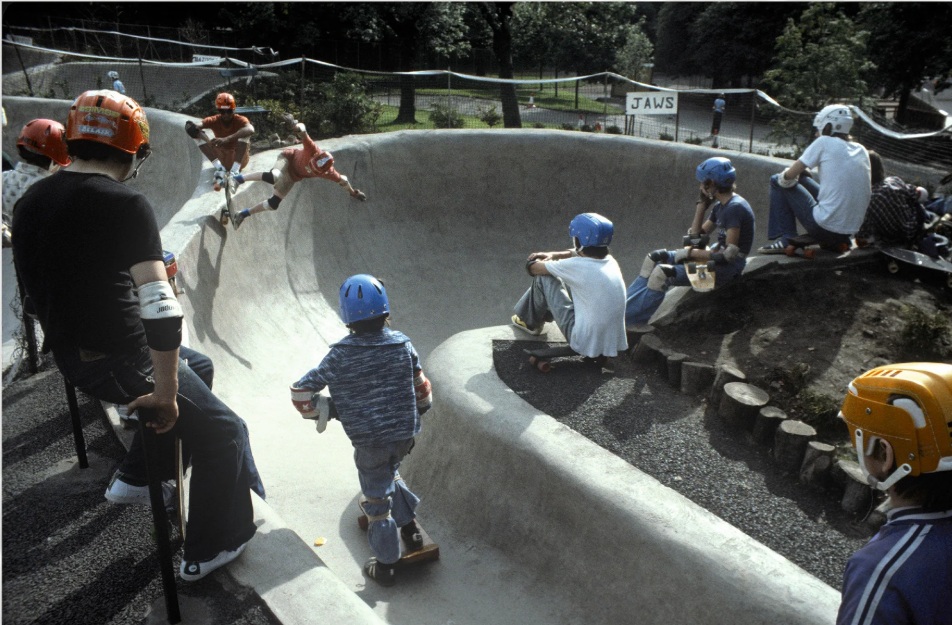 Iain Urquhart photo some old school action in the Jaws bowl (photo: Iain Urquhart / North Magazine)
Iain Urquhart photo some old school action in the Jaws bowl (photo: Iain Urquhart / North Magazine)
This inspired the idea to carry out the first archaeological excavation in the world of a concrete skatepark, which we did in August 2025. A team of students from Glasgow University, and skateboarders of all ages, worked on the #KelvinWheelies dig over five days, with the work funded by the Society of Antiquaries of Scotland and the archaeology department at the University of Glasgow. We also worked with Archaeology Scotland and their New Audiences programme; Kieran Manchip helped direct excavations working with volunteers arranged by the Scottish Refugee Council.
We opened up six trenches across four different features on the skatepark – you can see the locations on the sketch plan of the skatepark, below. In effect these trenches were exercises in carefully emptying out concrete bowls that had been buried by Glasgow Council in 1983 when the site was finally decommissioned. Excavations were carried out using hand tools, and we recorded everything with scale drawings, photography and in some cases photogrammetry. In keeping with the site, we also recorded excavations and team members with Polaroid instant photography. Finds were selectively retained but most were placed back in trenches during backfilling.
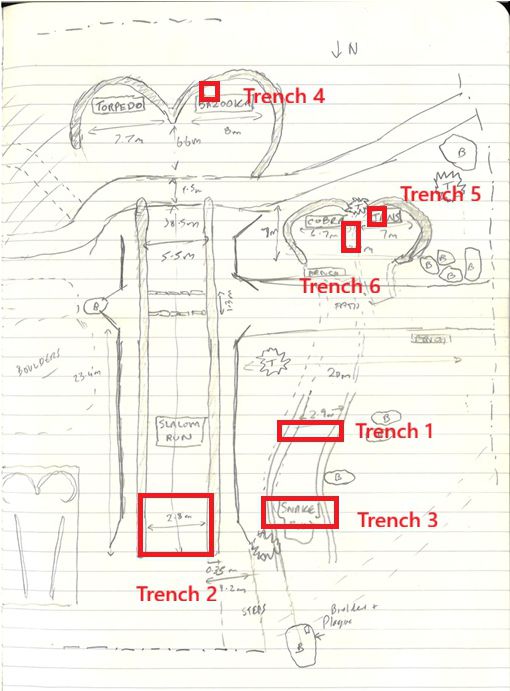
Sketch plan of the Kelvingrove Skatepark based on surface remains. Not to scale, north to the bottom of the image. Trenches 1-6 locations indicated (photo: K Brophy)
One large trench (Trench 2), measuring 3m by 5m, was opened at the north, top, end of the 50m long slalom run, and this showed the transition at the start of this ramp, and also a low concrete bank running down the middle. Two slots (Trenches 1 and 3) were cut across the Cobra slalom run, a more sinuous feature of the skatepark that originally led down into the Cobra Bowl. These both showed that the concrete was in excellent condition and provided some of the nicest sections I have seen on any excavation!
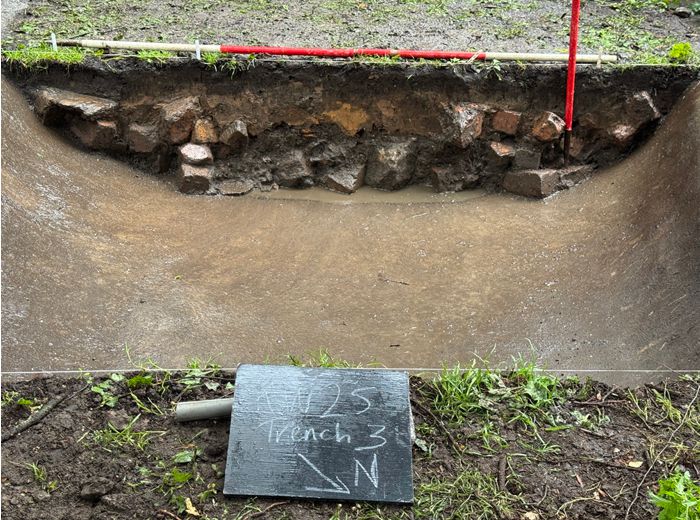
North-east facing section of Trench 3 across the Cobra slalom run showing several clear layers of material that was used to fill in this concrete feature (photo: K Brophy)
The slots across these two slalom runs showed that two different backfilling strategies has ben adopted by the Council. The main slalom run, in a prominent position in the park beside the Stewart Memorial Fountain, had been filled with good quality garden soil, and was probably for a time a flower bed. The Cobra run by contrast was filled with what appeared to be refuse and demolition debris, including large concrete chunks that were probably parts of the nearby Half Pipe feature that was completely destroyed. Bricks, linoleum, carpet tiles, and a door handle suggests some of this rubbish came from house demolition. We also know from archive research that the main slalom run was not filled in at the same time as other parts of the skatepark, which might also explain why they were decommissioned differently.
We opened some trial trenches (4-6) with the express aim of looking for concrete elements of buried bowls that might have graffiti left on them. We knew from photos of the skatepark in use that a lot of graffiti was evident on the concrete, although the Council tended to cover this in blocks of white paint. (Jamie told me that the skateboarders hated graffiti as it made the surface less grippy.) We did not attempt to empty the bowls as they were so deep. In the end, we found some white and black marks, and white blocks which presumably covered graffiti. In one trench we found, remarkably, a hologram of footballer Denis Law.
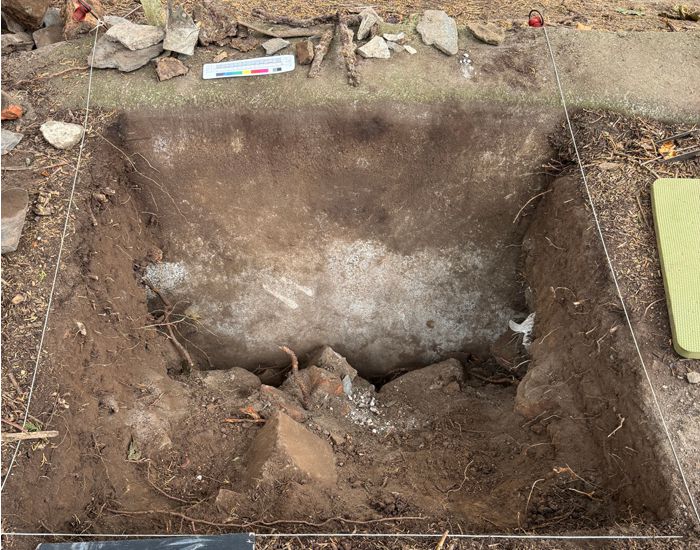
Trench 5 in the Jaws Bowl. This shows a block of white paint, probably added by the Council, and defiant strokes of white paint added later (photo: K Brophy)
Although we did not find any artefacts that were directly related to skateboarding, we did recover various sweet and chocolate wrappers with 1983 ‘best before’ dates, probably thrown in or dropped as the site was being backfilled. These confirm the year that the skatepark was decommissioned.
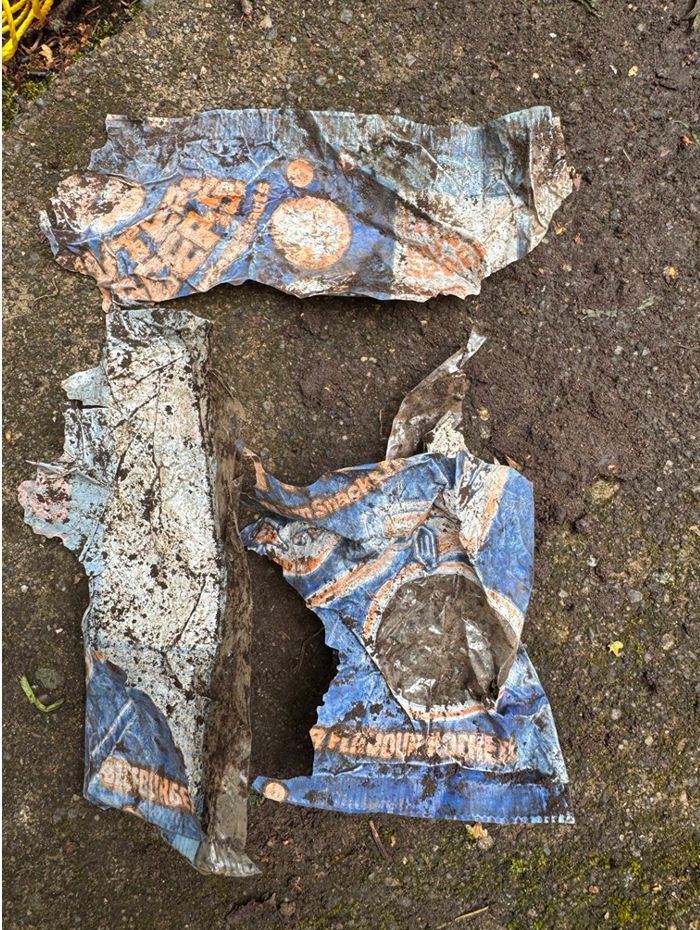
Packet of Outer Spacers (Hamburger Flavour) found in Trench 2, dating to the early 1980's (photo: K Brophy)
A digital archive of old school images of the skatepark, and further publications, will appear during the course of 2026. Many thanks to members of the public who sent me photos and archive material related to the skatepark, please do get in touch if you have pictures or video!

Cleaning Trench 2, at the north end of the Slalom run (photo: K Brophy)
Many thanks to Jamie Blair, our funders Society of Antiquaries of Scotland, and the permission and support of Glasgow City Council. Special thanks to the team who worked so hard on the excavations: Anthony Campbell, David Sandham, Hannah Baird, Hannah Iqbal, Emma Carstairs, Maya Ferrari, Stan Clark, Stuart Anderson and Owen Hurcumb; Carlos, Salah and Kaleab; and all our skateboarding volunteers!
Related links:
Find out more!
There is a podcast about the project, part of the University’s Stories from Glasgow podcast series (Series 5, Episode 3) – listen here or wherever you get your podcasts.
The excavations featured in Series 13, Episode 1, of the TV show Digging for Britain, available on the BBC iPlayer from 7th January 2026.
You can read more about the excavations and other skatepark heritage projects here.
Kelvin Wheelies on the BBC
The project is a collaboration between Dr Kenny Brophy and Masters research student Lorna Cummings. This is part of an ongoing collection of projects exploring the contemporary archaeology of Glasgow, most recently the archaeology of the 1988 Glasgow Garden Festival.
Images in this page are reproduced thanks to Jamie Blair, Parisa Urquhart (on behalf of the Iain Urquhart) and Kenny Brophy.


